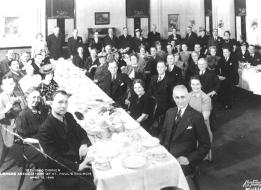| Teaching with Food |
![PDF-NOTE: Internet Explorer Users, right click the PDF Icon and choose [save target as] if you are experiencing problems with clicking.](http://rsnonline.org/templates/rsntemplate-smallmasthead/images/pdf_button.png) |
 |
Daniel Sack
Everyone eats. It’s a truism, but it’s a truism useful in teaching about religion. Eating is essential for human survival, and thus about as close to a universal as we can get. But, as anthropologist Mary Douglas (a guru for material culture studies) points out, “Food is a field of action. It is a medium in which other levels of categorization become manifest.” (Douglas, 30) People show who they are and what they believe through their food. Eating is universal, but what people eat and the way they eat it reveals a culture’s significant particularities. Everyday acts display a community’s commitments, beliefs, and practices. All of this means that food is a great way to teach about religion. I’ll illustrate a few of the advantages of using food as a focus for teaching about religion. Given my background and teaching experience, most of my examples are drawn from Christian traditions, but you can probably come up with parallels in the tradition you are teaching. Teaching with food provides a comparative perspective. As the truism notes, everyone eats. And just about everyone endows food with some religious meaning. That means you can compare and contrast religious traditions, with food as the common theme. How are the Christian Eucharist and Hindu offerings different? What do Jewish kosher law and African taboos have in common? What does it mean when Buddhists start having American-style potlucks? You can do the same thing across time as well — looking at how communion practices changed from the first century to the present, for instance. This comparative perspective shows our students that religion is of variety. The topic also allows teachers to make their classes more experiential. Recent pedagogical practices call for engaging students through their own experiences. I have found that almost everyone has a story to tell about religion and food — a family potluck story, or something about communion. Encourage your students to tell their story. When they connect their experience with the theory and content of your course, they understand it in a deeper way. They can also connect with other people’s experience through observer-participation exercises. Require them to attend a food-centered ritual. Ask them to analyze a family meal. Such assignments encourage your students to see religion in action. With food, as with other forms of material culture, learning becomes more immediate when it is directly experienced. A food-centered perspective offers a thick description of religious life. Food has multiple roles in a religious community. It can be the center of a ritual, as with the Passover Seder. It can be part of an important community-shaping event, like a youth group pizza party. Its preparation can be an ethical action, in the form of vegetarian cooking or serving at a soup kitchen. A focus on food reminds our students that religion is more than just theology, ethics, ritual, or practice; it is a
Similarly, food raises questions about religion and class. Many American religious communities are involved in some way in feeding the hungry. But what do they provide, and why? What do they expect of the hungry people that they feed? Some soup kitchens, for instance, require their clients to attend prayer services and go through Christian-based recovery programs. Others simply provide the food and hope that the guests pick up some faith from the atmosphere. There is also great variety in the menu. Many soup kitchens serve food gleaned from leftovers and donations, while others prepare meals to order from fresh ingredients. What do these differences tell us about those religious communities? Obviously, food has implications for ethics as well. What do you eat and why? Even in Christianity, a tradition with few official food taboos, eating is fraught with rights and wrongs. In the nineteenth century, food reformers like Sylvester Graham advised Americans to change their diets for the sake of their souls, and Good Housekeeping told readers “How to Eat, Drink, and Sleep as Christians Should.” In the twentieth, hunger activists urged Christians to become vegetarians so that the world’s hungry would have enough. Many religious traditions have similar systems of food taboos — formal or informal. As Douglas says, food is a field of action. It reveals a great deal about who people are and what they believe. As a result, a focus on food can be a creative way to engage students in the study of religion. Food is ubiquitous, so there’s always something students can connect with. It’s no wonder that the study of food has become hot across academia, resulting in a rich scholarship. It also has real promise in the religion classroom. ResourcesBynum, Carolyn Walker. Holy Feast and Holy Fast: The Religious Significance of Food to Medieval Women. Berkeley: University of California Press, 1987. Counihan, Carole and Penny Van Esterik, eds. Food and Culture: A Reader. New York: Routledge, 1997. Douglas, Mary. “Standard Social Uses of Food,” in Food in the Social Order: Studies of Food and Festivities in Three American Communities. New York: Russell Sage Foundation, 1984. Feeley-Harnik, Gillian. The Lord’s Table: The Meaning of Food in Early Judaism and Christianity. Washington and London: Smithsonian Institution Press, 1981. |


 Daniel Sack is Program Officer for the Associated Colleges of the Midwest. He was the Associate Director of the
Daniel Sack is Program Officer for the Associated Colleges of the Midwest. He was the Associate Director of the  Because food involves so much of religious life, it connects with a variety of issues. For instance, food has clear links to religion and gender concerns. Ask your students, who cooks and who eats? Traditionally, women have done most of the cooking in Christian churches. There has also been a great deal of recent scholarship about gender, body issues, and food — ranging from medieval nuns to contemporary teenagers. How does gender affect what we eat? Consider, for example, this passage from How to Plan Church Meals (1962), “Sandwiches for the tea table are quite a different thing from the ‘he-man’ sandwiches you want for a picnic, or the meal-in-one you serve to teenagers. They are delicate, made for nibbling - and looking pretty is far more important that providing nourishment.” This paragraph reveals a worldview, full of gender relations and social expectations.
Because food involves so much of religious life, it connects with a variety of issues. For instance, food has clear links to religion and gender concerns. Ask your students, who cooks and who eats? Traditionally, women have done most of the cooking in Christian churches. There has also been a great deal of recent scholarship about gender, body issues, and food — ranging from medieval nuns to contemporary teenagers. How does gender affect what we eat? Consider, for example, this passage from How to Plan Church Meals (1962), “Sandwiches for the tea table are quite a different thing from the ‘he-man’ sandwiches you want for a picnic, or the meal-in-one you serve to teenagers. They are delicate, made for nibbling - and looking pretty is far more important that providing nourishment.” This paragraph reveals a worldview, full of gender relations and social expectations.